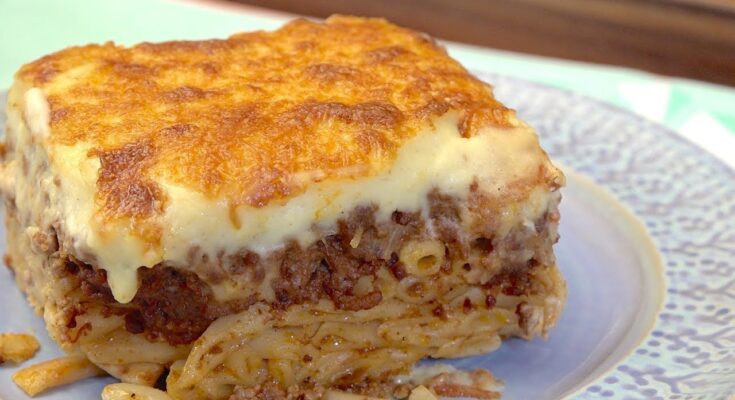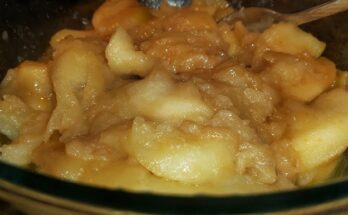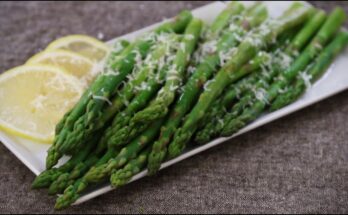Pastitsio Recipe: Craving something cozy, flavorful, and oh-so-satisfying? Let me introduce you to Pastitsio, a classic Greek baked pasta dish layered with spiced meat sauce, pasta, and a rich béchamel topping. It’s like lasagna but with a Mediterranean twist—comfort food at its finest. This dish is ideal for family gatherings, festive dinners, or anytime you want to bring Greek flavors to your table.
Let’s walk through a step-by-step guide on how to make authentic Greek pastitsio, ensuring every bite is layered with love and tradition.
What is Pastitsio?
A Taste of Greek Comfort
Pastitsio is one of Greece’s most beloved comfort foods. It features layers of pasta, a hearty meat sauce infused with spices like cinnamon and cloves, and a creamy béchamel sauce that bakes to golden perfection. Imagine the elegance of moussaka and the homely heartiness of a pasta bake, and you’ve got pastitsio.
The dish is a staple during Greek holidays, big family Sunday lunches, and is found on nearly every traditional Greek restaurant menu. It’s filling, rich, and balanced in flavor. That touch of cinnamon? Totally unexpected but undeniably delicious.
Historical Origins of Pastitsio
The word “pastitsio” comes from the Italian “pasticcio,” meaning pie or mess. The dish was influenced by Italian cuisine during Venetian rule in the Ionian Islands. Over time, Greek cooks adapted it, adding their own spices and flavors. Nikos Tselementes, a famous Greek chef, modernized pastitsio in the early 20th century by incorporating French culinary techniques, particularly the béchamel sauce.
The result is what we now recognize as modern Greek pastitsio—a true fusion of cultural flavors.
Key Ingredients for Authentic Pastitsio
Getting that traditional taste starts with the right ingredients. Let’s break it down into three essential components.
Pasta Layer
You’ll want long tubular pasta, like bucatini or penne. The pasta should be sturdy enough to hold the layers together but still soft enough to absorb the sauce. Greeks typically use “pastitsio noodles,” a thick macaroni with a hole in the middle, but if you can’t find them, no stress—ziti or rigatoni works great.
You’ll also mix the pasta with egg whites and cheese before layering, helping it stick together when sliced.
Meat Sauce Layer
The heart of pastitsio is its spiced meat sauce. Ground beef (or a mix of beef and lamb), onion, garlic, tomato paste, and red wine create a rich, deep flavor. But what sets it apart is the seasoning—cinnamon, cloves, bay leaf, and sometimes nutmeg. It’s these spices that give the sauce its unmistakably Greek character.
Cooked slowly, the meat sauce becomes thick and flavorful—perfect for layering.
Creamy Béchamel Sauce
This luxurious sauce tops everything off. Made with butter, flour, milk, eggs, and a sprinkle of nutmeg, béchamel is thick, velvety, and golden once baked. You’ll fold in grated cheese (usually kefalotyri or parmesan) for added richness.
Tip: Make sure to stir continuously when making the béchamel to avoid lumps.
Kitchen Tools You’ll Need
Before diving into the cooking process, here’s a quick checklist of tools you’ll need:
- Large pot for boiling pasta
- Large sauté pan for the meat sauce
- Medium saucepan for the béchamel
- Whisk (essential for the béchamel!)
- 9×13 inch baking dish
- Wooden spoon or spatula
- Mixing bowls
- Cheese grater
Having these ready ahead of time makes the cooking process smooth and enjoyable.
How to Prepare Traditional Greek Pastitsio
Time to bring it all together! Follow these steps, and you’ll be dishing out restaurant-quality pastitsio in no time.
Step 1 – Boiling the Pasta
Start by cooking your pasta in salted water until just al dente—don’t overcook, as it will continue baking later. Drain and mix with beaten egg whites and grated cheese. This helps the pasta bind together as it bakes and gives structure to your base layer.
Set aside while you prep the other layers.
Step 2 – Making the Meat Sauce
In a large pan, heat olive oil and sauté finely chopped onions and garlic until translucent. Add ground beef (or beef-lamb mix) and cook until browned. Stir in tomato paste, crushed tomatoes, red wine, and seasonings—cinnamon, cloves, bay leaf, salt, and pepper.
Let it simmer gently for 20–30 minutes. The sauce should be thick, rich, and aromatic.
Once done, remove from heat and let it cool slightly.
Step 3 – Preparing the Béchamel Sauce
The béchamel sauce is what sets pastitsio apart. In a medium saucepan, melt butter over medium heat. Stir in flour and whisk continuously to create a roux. Cook for about 2–3 minutes to eliminate the raw flour taste, but don’t let it brown.
Gradually add warm milk while whisking constantly to avoid lumps. As the mixture thickens, add a pinch of salt, white pepper, and a hint of nutmeg for that signature flavor. Continue whisking until the sauce reaches a creamy, pourable consistency.
Remove from heat and let it cool slightly before whisking in egg yolks and grated cheese. This enriches the sauce and gives it that golden finish once baked. The key is to keep whisking after adding the eggs to prevent them from curdling.
Step 4 – Assembling the Dish
Now comes the fun part—layering!
- Bottom Layer: Start by spreading half the pasta evenly across the bottom of a greased 9×13-inch baking dish.
- Middle Layer: Spoon all the meat sauce over the pasta and smooth it out. Press it down gently to compact the layers.
- Top Pasta Layer: Add the remaining pasta on top of the meat sauce and distribute it evenly.
- Béchamel Sauce: Pour the creamy béchamel over the top, using a spatula to spread it evenly. Don’t worry if it seems thick—it will melt beautifully during baking.
Sprinkle a generous layer of grated cheese (preferably kefalotyri or parmesan) over the top to form a golden crust.
Step 5 – Baking the Pastitsio
Preheat your oven to 350°F (175°C). Bake the assembled pastitsio for 45–50 minutes, or until the top is bubbly and golden brown. Let the dish rest for at least 20 minutes before slicing—this helps it set and makes for cleaner servings.
You can serve pastitsio with a light Greek salad or roasted vegetables to balance out its richness. It also tastes even better the next day, making it perfect for leftovers.
Tips for the Best Pastitsio Every Time
- Use high-quality cheese: Authentic Greek cheeses like kefalotyri or graviera offer the best flavor.
- Don’t skip the resting time: It makes slicing much easier.
- Make ahead: You can prepare the layers in advance and bake when ready.
- Spice wisely: Cinnamon is the secret weapon—but use it sparingly.
Serving Suggestions and Pairings
Pastitsio is rich, creamy, and satisfying on its own, but pairing it with the right side dishes and drinks can elevate your meal to a whole new level.
Side Dishes That Complement Pastitsio
- Greek Salad: A classic pairing. Crisp cucumber, juicy tomatoes, red onion, olives, and feta dressed in olive oil and oregano offers a fresh contrast to the rich pastitsio.
- Roasted Vegetables: Think zucchini, eggplant, and bell peppers drizzled with olive oil and herbs.
- Tzatziki Sauce: The garlicky, yogurt-based dip adds a refreshing zing when served on the side.
- Lemon Potatoes: Greek-style roasted potatoes with lemon and oregano are a deliciously tangy accompaniment.
Best Drinks to Serve with Pastitsio
- Red Wine: A dry Greek red like Agiorgitiko or a Syrah balances the dish’s spice and richness.
- White Wine: A crisp Assyrtiko can cut through the creamy béchamel.
- Beer: A light lager or pilsner works well.
- Non-Alcoholic: Sparkling water with lemon or a mild iced tea can help cleanse the palate.
How to Store and Reheat Pastitsio
One of the best things about pastitsio? It stores and reheats beautifully—perfect for meal prep or leftovers.
Storing in the Fridge
- Let it cool completely before covering tightly with foil or plastic wrap.
- Store in the fridge for up to 4 days.
- For best results, slice into portions before storing.
Freezing Instructions
- You can freeze both baked and unbaked pastitsio.
- Wrap tightly in plastic wrap and then foil. Label with date.
- It keeps well in the freezer for up to 3 months.
Reheating Tips
- Oven: Reheat covered at 325°F (165°C) until warmed through, about 20–30 minutes.
- Microwave: Use a microwave-safe plate and cover lightly with a paper towel. Heat in 1-minute increments.
- Add a splash of milk to maintain creaminess if reheating a single portion.
Variations and Substitutes
Don’t have all the ingredients? Or looking to switch things up? No worries—pastitsio is surprisingly adaptable.
Meat Alternatives
- Ground Lamb: Adds a more intense, earthy flavor.
- Ground Turkey or Chicken: A lighter alternative for a healthier version.
- Vegetarian Option: Use mushrooms, lentils, or plant-based crumbles in place of meat.
Dairy-Free Options
- Milk: Substitute with almond or oat milk for the béchamel.
- Cheese: Use a dairy-free cheese or nutritional yeast for cheesy flavor.
Pasta Options
- Gluten-Free Pasta: Works well if you’re gluten-intolerant.
- Whole Wheat Pasta: Adds a bit more fiber and a nutty flavor.
These changes can help make the dish suitable for various diets without compromising on taste.
Nutritional Value of Pastitsio
While pastitsio isn’t exactly low-cal, it is packed with nutrients—especially when you use high-quality ingredients and pair it with veggies.
| Component | Nutritional Benefits |
|---|---|
| Pasta | Provides carbohydrates for energy |
| Ground Meat | Rich in protein and iron |
| Tomato Sauce | Loaded with antioxidants like lycopene |
| Béchamel (with milk and cheese) | Source of calcium and healthy fats |
| Spices (Cinnamon, Cloves) | Anti-inflammatory and antioxidant properties |
If you’re watching your intake, consider smaller portions served with a large side salad.
Why You’ll Love Making Pastitsio at Home
Homemade pastitsio might take a bit of time, but it’s absolutely worth it. It’s comforting, nostalgic, and incredibly satisfying. Plus, it freezes well, feeds a crowd, and always impresses.
You can even involve the whole family in assembling it. Kids love layering the pasta and pouring the sauce, making it a fun kitchen project for all.
FAQs about Pastitsio Recipe
Q1: What is Pastitsio?
Pastitsio is a traditional Greek baked pasta dish layered with pasta, spiced ground meat (usually beef or lamb), and a rich, creamy béchamel sauce. It’s often described as the Greek version of lasagna.
Q2: Can I make Pastitsio ahead of time?
Yes! You can fully assemble the dish a day ahead, cover it tightly, and refrigerate it. Bake it just before serving. It also freezes well for up to 2 months.
Q3: What pasta is best for Pastitsio?
Pastitsio is traditionally made with long tubular pasta called “pastitsio noodles” or makaronia. If unavailable, bucatini or penne works great too.
Q4: Can I use a different meat besides beef?
Absolutely. Lamb is a popular alternative for a more authentic Greek flavor, but ground turkey or chicken also work if you want a leaner option.
Q5: How long does Pastitsio last in the fridge?
Stored in an airtight container, Pastitsio stays fresh in the fridge for up to 4–5 days. Just reheat in the oven or microwave before serving.
Q6: Is Pastitsio kid-friendly?
Yes! Most kids love the creamy, cheesy béchamel and mild meat sauce. You can even sneak in finely chopped veggies if you’re feeling sneaky.
Q7: Can I make Pastitsio gluten-free?
Yes, substitute with gluten-free pasta and use gluten-free flour for the béchamel sauce. The taste and texture will still be deliciously satisfying.
Q8: What side dishes go well with Pastitsio?
A crisp Greek salad, roasted vegetables, or a light lemony soup pair beautifully with this rich, hearty main dish.
Q9: Can I skip the béchamel sauce?
Technically, yes—but then it’s not truly Pastitsio. The béchamel is what sets this dish apart, adding a creamy, golden finish that’s downright irresistible.
Q10: What’s the difference between Pastitsio and Moussaka?
Both are classic Greek casseroles, but Moussaka uses eggplant instead of pasta and includes a similar meat and béchamel topping.
Conclusion
Pastitsio is more than just a meal—it’s a celebration of Greek tradition, comfort, and culinary craftsmanship. Whether you’re making it for a family dinner, a festive occasion, or just because you want a comforting plate of something delicious, this dish will never disappoint.
With its rich meat sauce, tender pasta, and creamy béchamel topping, every bite feels like a warm hug from Greece. So roll up your sleeves, gather your ingredients, and let this recipe transport you straight to the Mediterranean.



